
A Gift
May 29th, 2012
Black-Billed Cuckoos are shy, elusive birds. In five years of enthusiastic birding, I'd only ever seen one once--and I only saw him because my birding companion played a recorded call, convincing him that a rival male was in his territory.
Until today! I was hiking Greenbelt Pathway West when this fellow came right out in the open. He had apparently found an oak tree full of food (perhaps caterpillars--cuckoos have a voracious appetite for them), and was too caught up in his feeding frenzy to bother hiding from me.

It really felt like a gift from the universe.
Pink Ladyslippers
May 25th, 2012

I still remember the day, as a child, I found one lone pink ladyslipper growing in the woods behind my house. It seemed rare and special to me even then. That was before I knew why they're so uncommon. They require acidic soil, they're slow to develop, and if picked, they will not regrow. Most interestingly, ladyslippers can't sprout without the help of a symbiotic fungus. Their seeds are tiny and bear no food supply for the developing plant. The fungus penetrates the seed and nourishes it. Payback comes later when the fungus extracts nutrients from the roots of the mature plant.
Until recently, Mer Bleue bog was the only place I knew in Ottawa to find this flower. I've since discovered that the South March Conservation Forest (a wonderful natural area near our new home) has them in abundance!
Drama at the Nortel wetland
May 18th, 2012
Yesterday in the Nortel woods, I was walking along where some stones traverse a wet spot on the path, and heard a Sedge Wren singing. Sedge Wren is a small, shy and secretive bird, rare in Ottawa. It would be a lifer for me, so I spent some time trying to spot it, without success.
At some point, I saw one bird chase another out of the area. The chaser was a Common Yellowthroat. I couldn't tell who the chasee was, but after this occurrence, I didn't hear the wren sing again.
Today I went back armed with my IPod, and attempted to call the wren out (if it was still around) by playing its song. It never responded. I did get a response though--a big one! Common Yellowthroats in the area became agitated. They're normally skulkers (though not as secretive as Sedge Wrens) in thick vegetation, but as soon as I started playing that song, I had multiple yellowthroats popping up into the trees in plain view, looking around, scolding, and then singing at the top of their voices. I got some of the same reaction from nearby Swamp Sparrows.
One thing some people don't realize is that, while birdsong sounds cheerful to us, it's actually somewhat aggressive. It's an expression of self-assertion and fitness: "this is my territory and I've got what it takes to defend it." (Think of how much energy it takes to sing all day, as some birds do. Or how much guts it takes to do something that draws attention to yourself when you're a small bird surrounded by potential predators.) So the beautiful golden-throated bird popping into a tree and singing a bright, happy-sounding "witchety witchety witchety!" was the avian equivalent of a man flexing his biceps and saying, "oh yeah? Well check this out." (I even noticed an increase in general skirmishes, none of them involving wrens: birds chasing each other around, and such. It had the feel of a bar brawl. "Who, me? I didn't say it!") In fact studies have shown that birds' testosterone levels skyrocket when they hear the song of another of their species in their territory.
But this was a case of cross-species aggression, and, together with yesterday's event, suggested that Yellowthroats consider Sedge Wrens to be direct competitors. It made me wonder: could it be one of the reasons Sedge Wren is so secretive, uncommon and local (breeding in certain places one year and then gone the next) is because it can't stand up to other birds who share its habitat (sedge marshes and wet meadows)? It's 4 and a half inches long, which is smaller than most. Just an off-the-cuff theory.
The Wikipedia page gives me an idea of why a Sedge Wren might not be such a popular neighbor. It says, "he may puncture the eggs of other birds nesting nearby"!
The spring warbler paparazzi
May 6th, 2012
This Black-Throated Blue Warbler attracted quite the throng of nature photographers when he came down low in the branches at Mud Lake. It's an uncommon bird to see even in migration, and arguably, among the handsomest of warblers. I joined the paparazzi and managed to get one good shot through a small opening in the foliage.
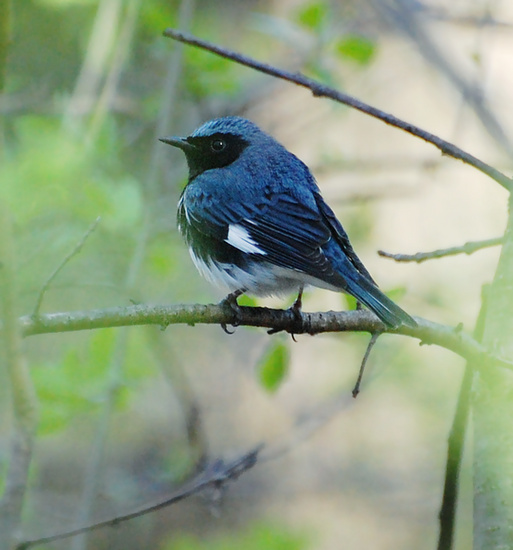
Palm Warblers are common migrants here, but rare breeders. Their favorite habitat is sphagnum bog, such as Mer Bleue, and that is in fact the only place in Ottawa to find them in summer.
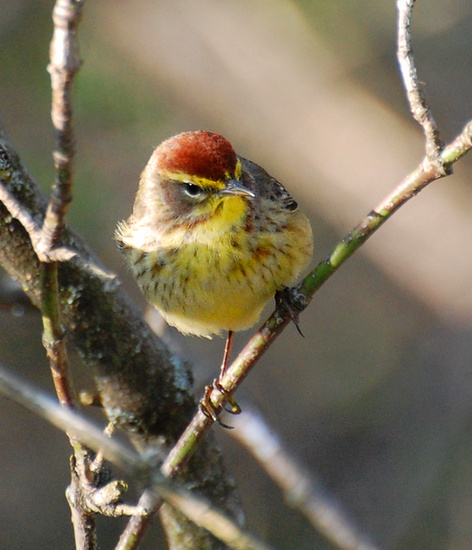
Ottawa birding is blowing my mind. I've never seen a spring like this. All of a sudden the land is exploding with birds--much the way it's exploding with color! I've seen and/or heard twenty new species between yesterday and today, including eight new warblers.
I also saw my first dragonflies, my first Black Swallowtail, my first ladybugs (eensy weensy ones crawling around on a dandelion), and got my first mosquito bite :-)
Contrast
May 3rd, 2012
A study in contrast of a Black-Capped Chickadee, red osier dogwood, and blue sky. This is an old photo that I don't think I've shared before.

1680x1050 wallpaper
Ethics of recorded bird calls
May 1st, 2012
I found this article to be a very informative guide on the ethics of bird call playback. I'm heartened to hear that no research has shown damage to breeding bird populations. My fear, that I might accidentally convince a bird to give up and desert its nesting grounds, appears unfounded. It seems that the worst that can happen is a breeding male can "lose face" with his neighbors and/or mate--and only in the case of aggressive (loud and prolonged) playback, where they will perceive him as the loser and the phantom rival as the winner.
Billing and cooing
April 29th, 2012
I've always found female Wood Ducks have a gentle, contented look about them. This one looked especially contented as her mate preened her head to toe.
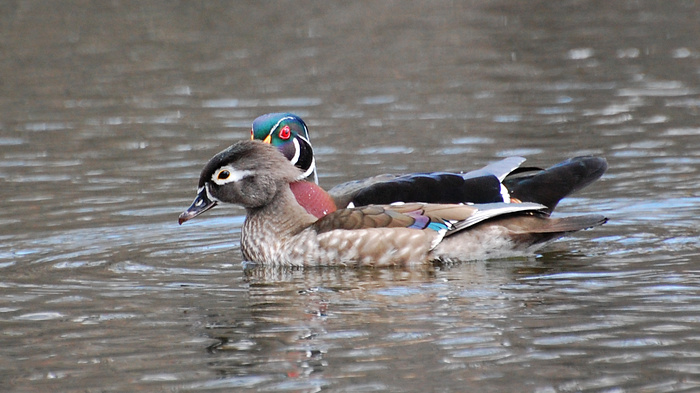
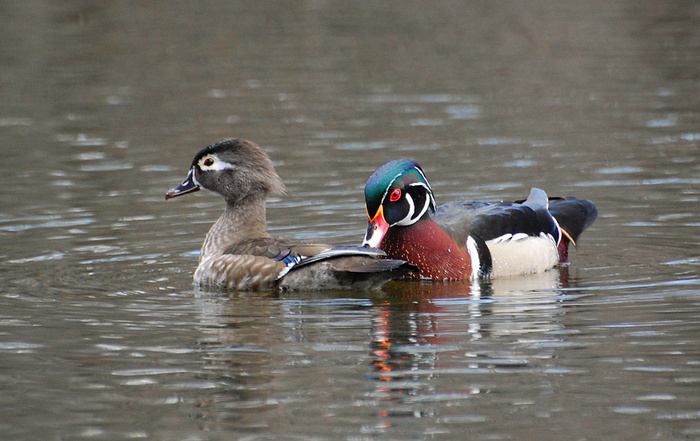
Rainbow crested
April 27th, 2012
Some very tame Wood Ducks have been hanging out at the north end of Mud Lake, near Cassels Road. Someone must be feeding them--the species is normally quite skittish. Whatever the reason, it's a photographer's dream come true!
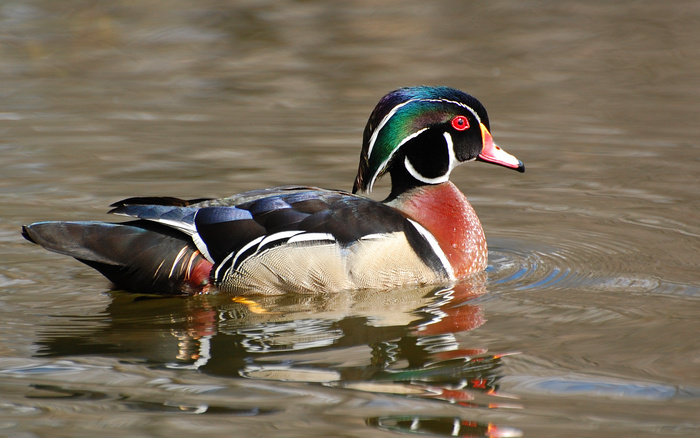
1680x1050 wallpaper

1680x1050 wallpaper
Aquatic snail is my best guess. Ducks can swallow them whole, and leave it to their gizzard to break the shell open.
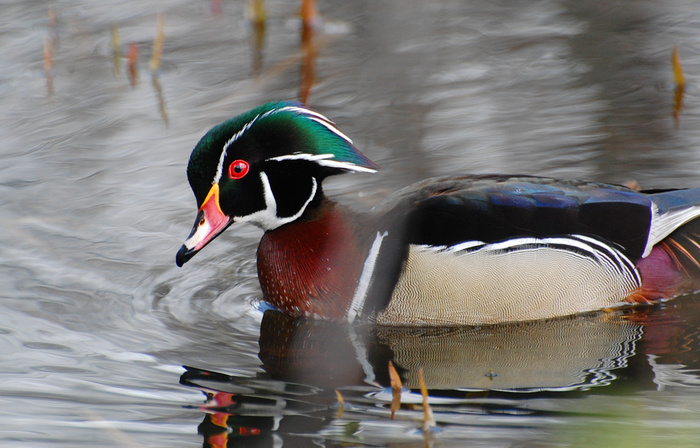
1680x1050 wallpaper
On rare occasions, I see a male Wood Duck with his crest poofed out instead of slicked back. I only ever see it in spring, so it must be intended to impress the ladies.
Spring migrants tough it out
April 26th, 2012
Our recent cold snap has been hard on the birds and butterflies that poured into Ottawa early, drawn by the deceptive summery weather. The many Yellow-Rumped Warblers at Mud Lake yesterday morning were mostly foraging on ground, scraping the bottom of the barrel in their search for insects and other invertebrates. Still, the males had enough energy to sing almost constantly.

Ruby-Crowned Kinglets too filled the air with their songs, and flashed their (normally concealed) ruby crowns at each other. Neither species breeds at Mud Lake, but birds often sing and display in spring migration--warming up, as it were.
Cold weather is ideal for photographing Ruby-Crowned Kinglets. They don't move around as fast!

Spring fever
April 22nd, 2012
It's been an interesting spring.
I haven't been racking up nearly the kind of yearlists as many of my birding acquaintances. I've been hearing more than I see of late. I have, however, had some neat experiences, including exploring some niches of Ottawa greenspace that I never knew about before.
One is the woods behind Nortel, to which I was introduced thanks to Gillian. I went there this afternoon with Michael and had an almost-lifer. We heard a loud, penetrating "kerlee!" coming from within a cattail marsh. I was able to confirm my suspicion when I got home: it was a sora, a type of rail, and one of the very few non-rare breeding birds in Ottawa that I have yet to lifelist. We watched and waited for some time, but without some means to draw him out of the marsh (like an IPod with a sora call on it), it was a lost cause. The cattails were just too thick.
More marshy excitement occurred later, alone. I was exploring Shirley's Bay, hiking a trail I'd never been on before, when I heard the telltale sound of winnowing snipe. (Yes, snipe are real, not just fictitious targets of "snipe hunts"!) These wetland birds perform an aerial courtship display, circling in the air as their wings make a distinctive sound. I followed the sound, and came to a marsh where I was also treated to the scratchy "kiddick kiddick" of a Virginia Rail and the unmistakable deep gurgling "poomp-a-loomp" of an American Bittern. It seemed about the most birdy marsh I'd ever found in Ottawa, in terms of diversity. Of course, it helped that I was there in the evening on an overcast day, as marsh birds tend to be nocturnal, but I'd been to the boardwalks at Stony Swamp many times at dusk and dawn, and never heard so much activity at once. I could only enjoy it by sound, though. The rail and bittern were well-hidden in last year's cattails, and the snipe, I guess, blended into the overcast sky.
Between them and the sora, it really tempted me to turn to the "dark side" and start taking an IPod (or similar) out when I bird. I have ethical qualms about coaxing birds with recorded calls, but with some, they're very hard to see any other way. Still, I enjoyed myself just listening, and my eyes got all the feast they needed when the overcast sky made way for a gorgeous sunset.
As I was walking down Rifle Road to my car, sunset trailing off into night, I had my final surprise. A buzzy "peent" sounded repeatedly from the woods beside the road. Then I started hearing more "peent"s, further down the road, and on the other side. I wondered "nighthawk?" at first, but that didn't seem right. If nighthawks were displaying I should be hearing the whooshing of wings, like I did in Okanagan, and the peents should be coming from the sky, not down in the woods. Besides: it's a little early. The birds that return to Ottawa in April are those that, while they may be partly or even primarily insectivores, can get by on other food if needed. Yellow-Rumped Warblers and Tree Swallows can eat berries. Pine Warblers can eat seeds from pine cones. Nighthawks eat flying insects. Period.
So I decided the peenters must be crickets or somesuch, and walked on. Then something twigged. Specifically this:
That was it. I was hearing woodcocks! Soon after I realized that, the air began to fill with twittering sounds, all up and down Rifle Road. Like snipe, woodcocks do flight displays in spring, but instead of winnowing, their wings chirp like a calling songbird. (Go to near the end of the video to hear it.)
In retrospect it was not a big surprise:
This common breeder is found in appropriate habitat from March to November. Easiest to find in April, when it does its fabulous mating flight from its chosen woodland opening or edge area. Check Shirley's Bay or March Valley Road (Fourth Line) - Klondike at dusk in spring, listening for the twittering flight "song" (really tail-feathers) or the repeated "peent" given when it returns to the chosen spot on the ground.But a treat for me, because while I'd read about woodcock spring fever many times, this was the first time I'd experienced it for myself.
- http://www.neilyworld.com/neilyworld/where.htm
It was really dark by then, but one of the peents sounded no more than ten feet from the road, so I focused my binoculars and scanned the ground. I found him--a shadowy figure, visible only when he moved. I almost couldn't credit what I thought I was seeing. But then the shadow took off suddenly, and I heard the chirping of its wings as it circled overhead. That's when I knew for certain. My first woodcock sighting of spring, and only my second ever. They are furtive, well-camouflaged birds, nigh impossible to find outside of spring display, unless you happen to flush one by walking right next to it (which is how I got my first.)
It struck me how, If I had just been driving my car down Rifle Road with the windows up, all this would have been going on around me and I'd have been none the wiser.
|
